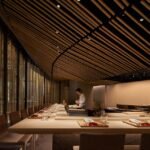[ad_1]
To outsiders, it would be a mistake to merely classify Kuching as just another city in Malaysia. It has had a long history as the capital of a self-governing state distinct from the affairs of the Malayan peninsula or even from Sabah. Even until this day, Sarawak has a separate immigration regime from the rest of Malaysia. All this means that visitors who come can expect something slightly different. There’s evidently more history here and a casual walk through the older parts of town can attest to that. This is despite Sarawak being sparsely populated and mostly forested.
The latter also presents plenty of eco-tourism opportunities. It is possible to go to the beach in the morning, go hiking through a hill or cave in the afternoon and come back in the evening for a great meal and a night cap. Speaking about food, this is also one of Malaysia’s food capitals with dishes such as Kolo Mee, Sarawak Laksa and Ayam Pansuh closely associated with the city as well as the state.
In this article, I aim to show how one can do Kuching in 1, 2, 3 or even 4 days with a Kuching itinerary that can easily be adapted depending on one’s interests.
Day 1
Explore the Colonial Architecture

kuching post office – colonial architecture in kuching
Immediately south of the waterfront is Kuching’s traditional civic core. This area is replete with colonial style buildings including the Main Post Office. Adorned by imposing neoclassical columns, the building was designed by architectural firm Swan & Maclaren which also designed several buildings in Singapore’s civic area including the Raffles Hotel.
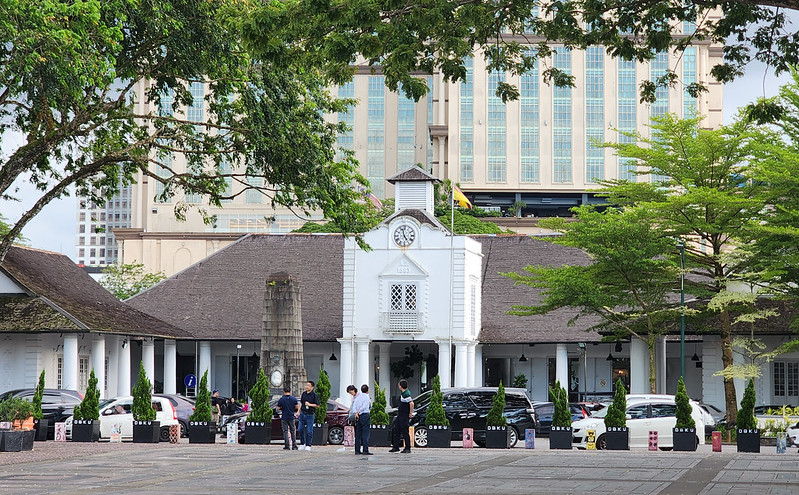
old court house
Some of Kuching’s old buildings have found a new lease of life as cafes and restaurants. One example is the Old Court House which now houses a cafe, bar and fine-dining restaurant. Visitors are free to roam some of these buildings. The Old Court House in particular, has a beautiful inner courtyard fitted with benches for folks to sit and relax.
Go Museum Hopping
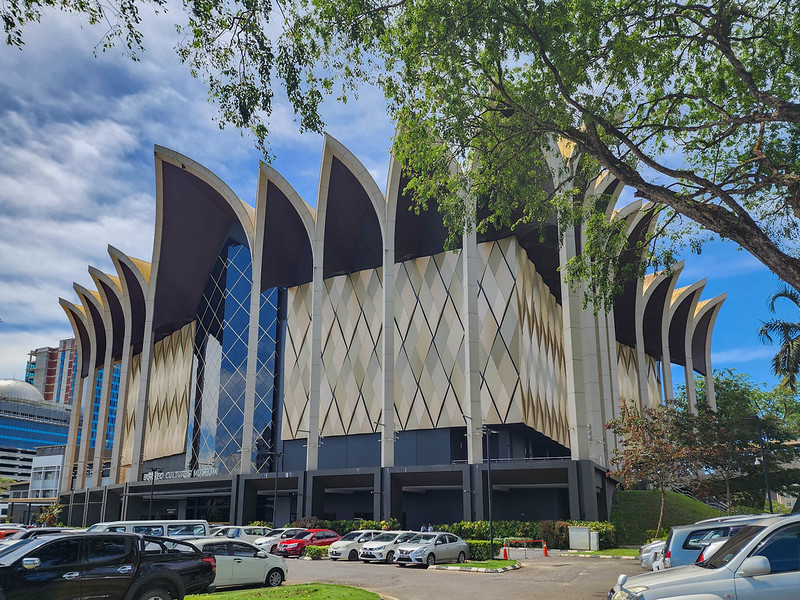
borneo cultures museum
In all my travels in Asia, I have not seen so many museums concentrated in one place. In Kuching, the museum selection ranges from the tacky, quick visit types to multi-story affairs that will take a few hours. The new Borneo Cultures Museum is a must-visit even if you are not really into museums. Anyone with more than a passing interest in tribal cultures, headhunting and early human settlements will find the exhibits here quite immersive. The museum itself also affords one of great views over the city. A short walk from it is the Sarawak Museum which was purposely built in the 1800s as an ethnology museum.
Near the waterfront is the Chinese History Museum. Admission is free and visitors can learn more about the various Chinese dialect groups that populate and make up a significant proportion of the city.
If you have time to spare, you can also check out the rather kitschy Cat Museum, built simply because Kuching’s name means “cat” in Malay (although cats were not a significant part of the city’s origins). This museum is filled with plenty of cat and feline memorabilia and exhibits.
Strolling Through Jalan India & Jalan Carpenter
Kuching is large enough for all the urban creature comforts but its streets are still relatively free of air pollution and quite pleasant to walk around (when it’s not too hot). As the city has been the capital of Sarawak for over 180+ years, the old commercial areas are charming with plenty of photo-worthy corners to check out. The two streets to go for a stroll in Kuching are Jalan India, the traditional home of the local Indian population in Kuching, as well as Carpenter Street – the city’s first Chinatown.

jalan india
Jalan India today has a large cover above the shophouses to protect pedestrians from the rain. The street is pedestrian-only and is filled with bazaars. Lorong Kai Joo is an alley off Jalan India where one can find age-old bakeries and teahouses. Hiap Yak Tea Shop is where people come for a cup of coffee and toast in a retro setting. It is known for opium coffee – essentially black coffee flavored with a slab of butter.

looking at jalan bishopsgate from jalan carpenter
Jalan Carpenter is a relatively short stretch filled with furniture stores, bars, Chinese restaurants as well as a few cafes and the odd souvenir shop. As Kuching is not an extremely touristy place, the area still has a very local feel. Drunk Monkey is a popular watering hole in the area with a rather sparse but sufficient menu. If you are looking for cocktails, the 2-story The Royal Chamber might be more up your alley. For coffee lovers, Black Bean Coffee towards the end of the stretch is regularly regarded as one of the best coffee places in Kuching. While they don’t have an instagrammable cafe to boast of and seats are rather limited, they offer various types of coffee beans including those from Sarawak itself.

In the eastern side of the city center, Jalan Padungan is also worth a stroll. The arcaded shopfronts seemingly alternate between restaurants, shops selling Kuching snacks and auto supply / hardware stores. Here, you can stock up on Kuching delicacies such as Bee Pang (crispy rice cakes), Almond Cookies, etc. On both ends of the street, you can also see variations of Kuching’s famous cat statues.
Take a Sampan to Fort Margherita

fort margherita
From the city center, hire a sampan for the 5 minute or so journey to the northern bank of the river and visit Fort Margherita. Situated on a hill overlooking the town, this historical building was built to fend off pirates and has been converted into The Brooke Gallery – a museum dedicated to Charles Brooke, the “White Rajah” who previously ruled Sarawak.
Tip: If you also intend to visit The Ranee Museum inside the Old Courthouse, purchase the Explorer Pass which gives you admission to both Fort Margherita and The Ranee Museum.
Explore the Waterfront
The waterfront of Kuching is one of its defining features and makes for one of Malaysia’s most picturesque city panoramas. With a river that curves gently in all the right places and a number of landmarks strategically built by the riverbanks, the waterfront is an active meeting point both in the day and at night. Early in the morning and in late afternoon, one can catch joggers zipping through the well-paved promenade. At night, families gather here for supper or a pleasant evening stroll.
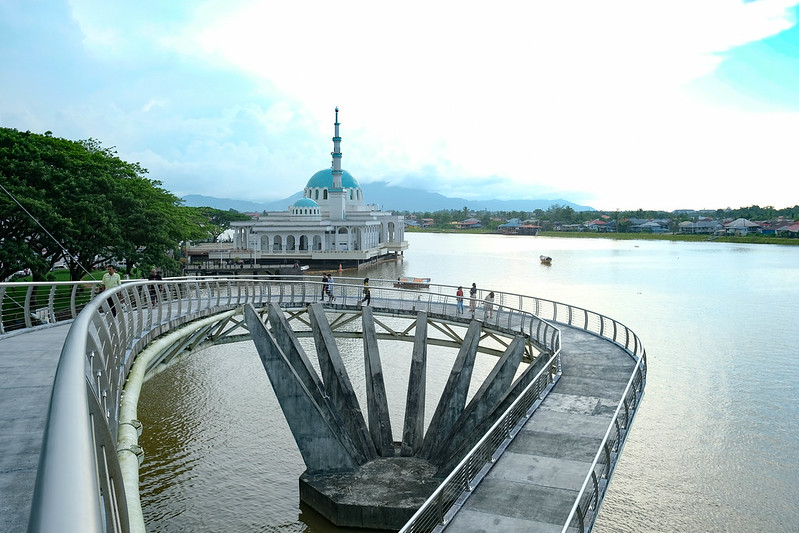
darul hana bridge
The Darul Hana Bridge is a twirling pedestrian bridge that connects the northern part of town with the south. The design contains traces of local tribal culture with the hornbill topped towers paying homage to the Bidayuh culture. This is the best place to catch the sunrise or sunset in Kuching in my opinion if you don’t have access to a rooftop / high view point. At night, there is also a light and water show by the river. Called the Darul Hana Musical Fountain, the schedule is as follows: 8:30PM and 9:30PM daily with an additional one at 10:30PM on Friday and Saturday.

From the bridge, one can have a closer view of the Sarawak State Legislative Assembly. Depending on who you ask, it said to resemble either a royal Malay umbrella (payung negara) or a traditional multi-pointed hat from the Iban tribe. The building was opened in 2009 and is now probably the best known architectural landmark of the city. For your best bet in getting postcard worthy shots of the assembly building, I can suggest going in the afternoon (any time after 2pm) to see the sunlight shining on its exterior.
Try Sarawakian Cuisine

lepau
For dinner, head to Lepau for a dose of local Sarawak cuisine. The menu offers a rundown of the specialties including Ayam Pansuh – chicken cooked in bamboo stalk and covered in tapioca leaves, Tempoyak (fermented durian) served with a variety of meats – as well as Midin (forest ferns).
Day 2
Semenggoh Wildlife Reserve

semenggoh wildlife centre
A trip to Kuching is probably incomplete without a visit to the Semenggoh Wildlife Centre for a round of orangutan spotting. The park is roughly 35 minutes from Kuching and is a habitat for wildlife rather than a zoo. As such, it is not always guaranteed that one can spot orangutans during a visit although chances are fairly high. The only exception is during fruit season (typically between October to March) when the orangutans can easily find food to eat from the forest and as such, do not need to go to the feeding area, where the galleries are located, for food.
Unless you have your own car, it is recommended to visit Semenggoh Wildlife Reserve as part of a join-in tour (you can book an inexpensive one here) because it is located in the wilderness and it might be difficult to find a Grab / taxi back. A typical tour lasts for about 3 hours and can be opted for either the morning of afternoon. Visits are timed to coincide with the feeding schedule.
Bau

tasik biru in bau
The town of Bau is located some 45 minutes to 1 hour away from Kuching. This former mining town is famous for its caves, mountains as well as the manmade Taman Tasik Biru, a former gold mine that has been filled with water. The relatively serene surroundings makes it a conducive place to rent a boat or to just sit by one of the lakeside sheds and watch the world go by.

paku rock maze garden
A relatively new attraction is Bau is the Paku Rock Maze Garden – a beguiling rock formation just off the highway connecting Kuching and Bau. It is literally a rock maze – with the 2-meter tall (or more!) rock formation creating natural passageways within the forest. While it is possible to get lost within the rock maze, fret not. Signs are scattered within the complex to guide visitors to the right path. Admission is free.
In Bau, one can also visit the 2 caves: Wind Cave and Fairy Cave which are about 7km away from each other. The 2 caves can be visited within a few hours. Bring insect repellant and flashlights. Some parts of the Wind Cave are pitch dark.
Siniawan

siniawan night market
End your day of exploration in the one-street town of Siniawan. Every Fridays to Sundays, this quiet row of wooden shophouses comes alive with lanterns, a night market and street stalls selling various snacks. Tables are laid out on the street and visitors can partake in various Sarawak and Malaysian dishes. If you love soaking in the old town vibes, it’s worth the 15 minute journey here from Bau. To get back to Kuching, allow for about 40 minutes drive.
Day 3
Enjoy a Hearty Bowl of Kuching’s Quintessential Kolo Mee

Kolo Mee is to Kuching as Pho is to Vietnam. If you were to think of one iconic dish to come from the Cat City, it would most likely be these bowls of curly, springy noodles with minced meat, char siu and doused with a light sauce. It can be had at any time of day but is most commonly eaten as a breakfast dish. You can have it plain which is the standard version or opt for a “red” version which comes with char siu sauce. Whichever version you go for, it’s easy to find kolo mee in any coffee shop in Kuching. Popular spots for a bowl include Chong Choon Cafe and Choon Hui Cafe. The latter is also popular for Sarawak Laksa.
Sarawak Cultural Village

sarawak culture village
Located near Mount Santubong is the Sarawak Cultural Village. Think of it as a living museum – with reconstructions of traditional houses of the tribes living in Sarawak. This is a good way to gain a quick overview of the many indigenous cultures found in the state without having to travel to Sarawak’s remote areas. The village also boasts of peaceful ponds, attractive foliage and photo-worthy sections. Don’t miss the enthralling cultural performance at the end. If you head there in the morning, you can expect to be back in Kuching by about 1:30PM to 2PM. You can join a group tour to the village here with hotel pick-up included.
Shop for Handicrafts
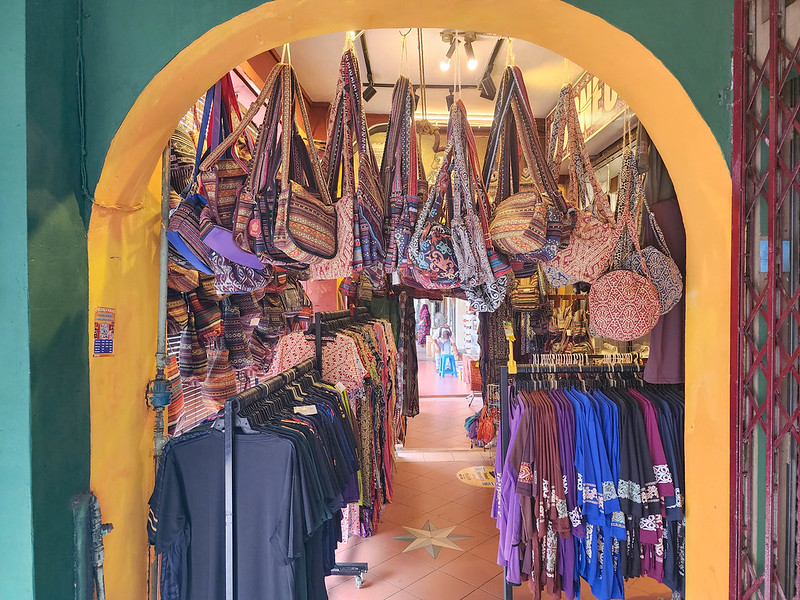
Kuching is a great place to buy authentic tribal handicrafts. If you love rattan, beadwork, woven cloths, carvings and intricate patterns; the shops along the main bazaar – the shophouses facing the waterfront – offer plenty of choices. Quality varies as well and haggling is expected in the smaller stores. Many of the products are expertly done and don’t carry any kitschy “Sarawak” or “Kuching” logo on them. I personally bought some baskets with intricate woven patterns as decorative wall art. For something more upmarket, you can check out the souvenir shop inside The Ranee Boutique Suites or the Sarawak Craft Council.
Seafood Dinner at Top Spot

Located in a nondescript building is Topspot Food Court, Kuching’s most popular spot for seafood. Located at the topmost floor of the building, the venue hosts dozens of seafood stalls with a communal dining hall. Dishes to try here include spiny lobsters, bamboo shells, crab and prawns that can be cooked to your liking. Check out the local version of the oyster pancake which is presented as a thin UFO-shaped cracker with the oysters studded throughout the surface.
Day 4
Bako National Park
If you have another full day to spare in Kuching or timed your departure for the evening, you can head out to Bako National Park which can be done as a day trip. What makes this national park special is that its coastal setting affords one of a variety of experiences – including jungle trekking, chilling by the beach and taking a boat ride out to see some rock formations.
A typical trip to Bako National Park involves going through one of the trails, each with its own unique features and having varied levels of difficulty. For beginners, the Paku Trail is relatively short, with little change in terrain. The trail ends at the beach. Other tails include the Tajor Trail, Limbang Trail and for those seeking a challenge – the Limau Trail which also end on the beach. While trekking through the park, your guide will try to seek out proboscis monkeys. These big-nosed primates are found all over Borneo, especially in the coastal and mangrove areas. You can join a day tour to Bako National Park here.
Another option is to head to Gunung Gading National Park for another day tour to see the Rafflesia flower (if it’s in bloom). The tour typically lasts until 3:30PM to 4PM and involves a hike to see the flower if it’s in bloom, waterfalls as well as a spot of swimming.
Other Tips for Kota Kinabalu
- Travel insurance: It may be advisable to get travel insurance, especially in this age of uncertainty. If you come from Singapore, I can recommend checking out Starr TraveLead for its cheap single- trip travel insurance with S$10 cash rebate to help offset the insurance cost here. If you are based elsewhere, check out Worldnomads as they have quite an extensive coverage, even including personal accidents into their list of benefits.
- Weather: Kuching is the wettest major city in Malaysia and it can rain any time of the year. However, it is the wettest between November to March where rains can be expected for 25 out of the 30 days of the month. That being said, it usually does not rain the entire day but plans for outdoor activities may be dampened by strong winds, flash floods and other inconveniences.
- Practicalities: Outside of Kuching’s arcaded streets of Jalan Carpenter, Jalan India, Main Bazaar and Jalan Padungan; most of Kuching’s streets offer little shelter from the heat and the rain. As such, if you walk outdoors during the day; you’ll most likely be baked under the sun. It’s wise to put sunblock even if you’re just staying within the city.
- Farther afield: Kuching serves as a hub for Sarawak so if there’s an interest in exploring more, you can fly to Brunei and Labuan. Sibu and Miri are also reachable by air.
Where to Stay
Budget: The Meritin Hotel is an affordable 3-star hotel located in Jalan Padungan, a street filled with quaint shops, cafes and restaurants. Rooms are clean, functional and for families wishing to stay together, they have a Family Room category featuring 2 double beds.
Midrange: When it comes to location, it’s hard to find any other hotel with a better placement than The Waterfront Hotel Kuching. The hotel is located right smack in the middle of town, in between Jalan India and Jalan Carpenter. The waterfront is 3 minutes walk and the Old Court House is directly beside it. The main museums are 2 blocks away. Rooms here are spacious and they also have a Family Room category with 2 double beds. The small supplement for a river facing room is well worth the upgrade and you can watch the nightly light show from the comfort of your room.
[ad_2]









